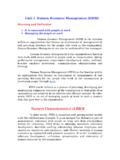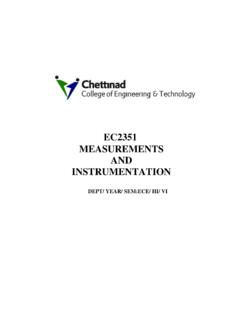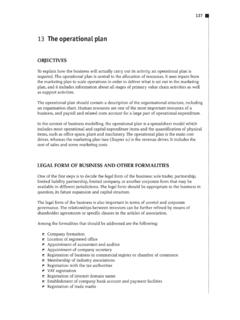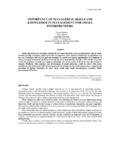Transcription of 2.2 Cost Of Capital - Chettinad College of …
1 Fianancial Management & international finance66 cost -VOLUME-PROFIT ANALYSISF inancial Management cost Of CapitalINTRODUCTION:It has been discussed in lesson -4 that for evaluating Capital investment proposals according tothe sophisticated techniques like Net Present Value and Internal Rate of Return, the criterionused to accept or reject a proposal is the cost of Capital . The cost of Capital plays a significantrole in Capital budgeting decisions. In the present lesson the concept of cost of Capital and themethods for its computation are OF Capital -KEY CONCEPTS:The term cost of Capital refers to the minimum rate of return a firm must earn on its invest-ments.
2 This is in consonance with the firm s overall object of wealth maximization. cost ofcapital is a complex, controversial but significant concept in financial following definitions give clarity J.: The cost of Capital may be defined as the rate of return the firm requires frominvestment in order to increase the value of the firm in the market place .James C. Van Horne: The cost of Capital is a cut-off rate for the allocation of Capital to invest-ments of projects. It is the rate of return on a project that will leave unchanged the market priceof the stock.
3 Soloman Ezra: cost of Capital is the minimum required rate of earinings or the cut-off rate ofcapital expenditure .It is clear from the above difinitions that the cast of Capital is that minimum rate of returnwhich a firm is expected to earn on its investments so that the market value of its share ismaintained. We can also conclude from the above definitions that there are three basic aspectsof the concept of cost of Capital :i)Not a cost as such: In fast the cost of Capital is not a cost as such, it is the rate of returnthat a firm requires to earn from its )It is the minimum rate of return: A firm s cost of Capital is that minimum rate ofreturn which will at least maintain the market value of the )It comprises three components:This Section includes.
4 cost of Capital -Key Concepts Importance Classification Determination of cost of Capital Computation Weighted Average cost of Capital67 Fianancial Management & international financeK=ro+b+fWhere, k= cost of Capital ;ro= return at zero risk level:b = premium for business risk, which refers to the variability in operating profit (EBIT) due tochange in = premium for financial risk which is related to the pattern of Capital OF cost OF Capital :The cost of Capital is very important in financial management and plays a crucial role in thefollowing areas:i) Capital budgeting decisions: The cost of Capital is used for discounting cash flowsunder Net Present Value method for investment proposals.
5 So, it is very useful incapital budgeting ) Capital structure decisions: An optimal Capital is that structure at which the valueof the firm is Value of the firm is maximum and cost of Capital is the lowest. So, costof Capital is crucial in designing optimal Capital )Evaluation of final Performance: cost of Capital is used to evaluate the financialperformance of top management. The actual profitabily is compared to the ex-pected and actual cost of Capital of funds and if profit is greater than the cast ofcapital the performance nay be said to be )Other financial decisions: cost of Capital is also useful in making such other finan-cial decisions as dividend policy, capitalization of profits, making the rights issue, OF cost OF Capital : cost of Capital can be classified as follows:i)Historical cost and future cost .
6 Historical costs are book costs relating to the past,while future costs are estimated costs act as guide for estimation of future )Specific Costs and Composite Costs: Specific accost is the cost if a specific sourceof Capital , while composite cost is combined cost of various sources of Capital . Com-posite cost , also known as the weighted average cost of Capital , should be consid-ered in Capital and Capital budgeting )Explicit and Implicit cost : Explicit cost of any source of finance is the discountrate which equates the present value of cash inflows with the present value of cashoutflows.
7 It is the internal rate of return and is calculated with the following for-mula;Fianancial Management & international finance68 cost -VOLUME-PROFIT ANALYSISF inancial Management (I K)(I K)(I K)=++++++Io = Net cash inflow received at zero of timeC = Cash outflows in the period concernedK = Explicit cost of capitalN = Duration of time periodImplicit cost also known as the opportunity cost is the of the opportunity foregone in order totake up a particular project. For example, the implicit cast of retained earings is the rate ofreturn available to shareholders by investing the funds )Average cost and Marginal cost : An average cost is the combined cost or weightedaverage cost of various sources of Capital .
8 Marginal cost of refers to the average cost ofcapital of new or additional funds required by a firm. It is the marginal cost which shouldbe taken into consideration in investment OF CAST OF Capital :As stated already, cost of Capital plays a very important role in making decisions relating tofinancial management. It involves the following in determination of cost of Capital :i)Conceptual controversy regarding the relationship between cost of Capital and capitalstructure is a big )Controversy regarding the relevance or otherwise of historic costs pr future costs indecision making )ReeComputation of cost of equity Capital depends upon the excepted rate of returnby its investors.
9 But the quantification of expectations of equity shareholders is avery difficult )Retained earnings has the opportunity cost of dividends forgone by the sharehold-ers. Since different shareholders may have different opportunities for reinvestingdividends, it is very difficult to compute cost of retained )Whether to use book value or market value weights in determining weighted aver-age cost of Capital poses another OF cost OF Capital :Computation of cost Capital of a firm involves the following steps:i)Computation of cost of specific sources of a Capital , viz.
10 , debt, preference Capital ,equity and retained earnings, and69 Fianancial Management & international financeii)Computation of weighted average cost of of Debt (kd)Debt may be perpetual or redeemable debt. Moreover, it may be issued at par,at premium ordiscount. The computation of cost debt in each is explained / irredeemable debt:i)At par:Kd = cost of debt before tax =I/PoKd = cost of debt; I= interest; Po = net proceedskd(after-tax) = i/P(I-t)Where T = tax rateExampleY Ltd issued Rs. 2,00,000, 9% debentures at a premium of 10%. The costs of floatation are 2%.










